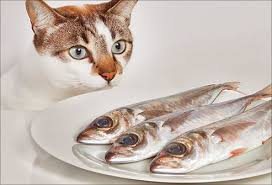
Myths and Truths About Feline Nutrition
Myth #1: “Canned food makes my cat fat.”
Truth #1: Dry food is actually more likely to make cats fat. Cats are true carnivores meaning they only utilize protein and fat from the diet. They lack enzymes needed to break carbohydrates down into absorbable energy. Fat and protein are the moistest part of a dry food. There is only so much that can be put in and still have a dry kibble. Protein is also the most expensive component to making pet food. Thus, most dry food has a lot of carbohydrates and fiber and less protein and fat making it exactly the opposite
of what a cat would feed itself in the wild.
If we as owners were to feed our cats strictly based on what is best for them and not easiest for us, we would feed an all canned diet. Canned food is high in moisture, high in protein, high in fat and very low in carbohydrates. Short of eating mice, this is the diet that is best matched to their physical needs.
If you must feed dry food, look for a diet that is 45-50% protein. This means it will be much lower in carbohydrates and it also means it will be more expensive. However, it is going to be very well absorbed and utilized by the cat meaning you can feed less of it.
Myth #2: “Canned food causes dental disease”
Truth #2: Food plays very little role in formation of dental disease. Cats being carnivores, they have pointed teeth made for puncturing, shearing, tearing and crunching/breaking small bones. They do not have flat teeth made for pulverizing kibble and chewing like we do. Dental disease in cats is primarily determined by genetics. Some cats, like people, just have more inclination for dental disease than others.
There are certain pure bred cats that are known to have more dental disease than others so this is something to be aware of when purchasing a pure bred cat.
Myth #3: “Free feeding means offering unlimited quantities of food”
Truth #3: Cats do like to free feed, meaning have food available all the time, so they can go and eat small meals frequently, but the amount offered should still be controlled. Cats will often eat canned food more in meals but if they don’t finish it, it can sit out for them to come back to for up to 12 hours. If you are free feeding dry food, it should be a set amount each day. Most cats need to eat less than 1⁄2 cup of dry food for 24 hours. Many people will split this into two 1⁄4 cup meals put into the bowl to eat throughout
the day and overnight.
So, in summary, feeding your cat a low protein, dry only diet is like a person eating fast food for every meal. It might taste delicious but it isn’t healthy for you. Being overweight and having excessive exposure to carbohydrates can lead to diabetes, high blood pressure and joint problems just as it can in people.
Look at the percentage of protein and fat in the diet you are offering your cat and try to remember that they require different things than dogs or people. Cats are not “little dogs” but more like “little panthers”.



